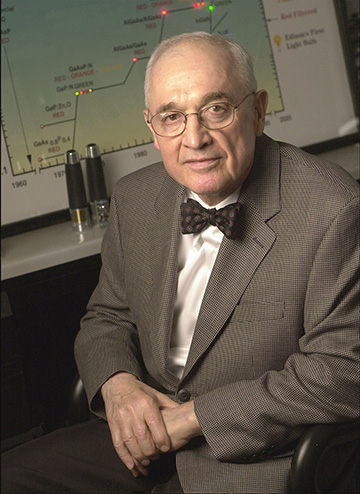![]()
[Image: Getty Images]
The 2021 Queen Elizabeth Prize for Engineering has gone to five pioneers in the creation of LED lighting, the foundation of “all solid-state lighting technology” and a cornerstone of modern green energy. The winners are OSA Honorary Member Nick Holonyak Jr., M. George Craford, OSA Fellow Russell Dupuis, and 2014 Nobel Physics laureates Isama Akasaki and Shuji Nakamura.
The QE Prize—billed as the most prestigious in engineering—includes a total cash award amounting to £1 million (roughly US$1.37 million) divided among the five recipients. It seeks to “celebrate groundbreaking innovation in engineering” and by that means to inspire the next generation of engineers.
Vast impact
In announcing the prize recipients, Lord Browne of Madingley, the prize chair, highlighted the remarkable potential impact of solid-state lighting on the world’s energy future. He noted that, compared with the incandescent technology of a century earlier, LED lighting is 98% cheaper, derives from safe, long-lasting materials, and consumes 90% less energy.
In a press conference following the announcement, Lord Browne underscored the weight those attributes could swing in reducing the world’s carbon budget. “If the world converted to LED lighting universally,” he maintained, “it would save 1.5 billion tons of carbon dioxide a year.” And, he added, the world is only “about halfway through that,” showing that the technology continues to have substantial scope for contributing to climate-change solutions.
The creation of modern solid-state lighting has also spawned an industry predicted to be worth US$108 billion by 2025, according to the Queen Elizabeth Prize Foundation.
Distinctive roles

OSA Honorary Member Nick Holonyak Jr. was one of five honorees awarded the 2021 Queen Elizabeth Prize for Engineering, for their accomplishments in creating, developing and commercializing LEDs and solid-state lighting technology. (Interestingly, two of the other 2021 recipients, Shuji Nakamura and M. George Craford, have been recipients of the OSA award named in Holonyak‘s honor.) [Image: Courtesy of QE Prize Foundation]
Each of the five honorees played a distinctive role in the path from the conception of LEDs in the early 1960s to the widespread commercialization of solid-state lighting technology seen today. Holonyak was the first person to create a visible-light LED (in the red part of the spectrum), and substantially developed the semiconductor technology behind them; all modern white LEDs flow from his seminal work. Craford added shorter-wavelength, yellow LEDs in 1972 and moved forward technology to create aluminum-indium-gallium-phosphide (AlInGaP) materials, as well as creating technologies that boosted LED efficiencies by a factor of ten.
Dupuis developed the metal–organic chemical vapor deposition (MOCVD) process for growing the semiconductor materials behind LEDs. In so doing, he created an industrially scalable process that, he noted in the press conference, is used today in thousands of large-scale industrial reactors to fashion LED materials. The process was particularly important because of its ability to handle aluminum, a difficult material for previous approaches.
Finally, Akasaki and Nakamura completed the drive to white-light LEDs for illumination through their work on materials and techniques for creating blue LEDs, which could be combined with other LED technologies to churn out tunable white light. (In 2014, the pair was honored for their achievements, along with OSA member Hiroshi Amano, with the Nobel Prize in physics.)
Broad impacts
Asked at a press conference after the announcement about the impacts of their work that have most surprised them, three of the 2021 QE Prize laureates offered up glimpses into the extraordinary breadth of the technology.
Dupuis, for example, noted the importance of controllable LED illumination in making feasible new forms of agriculture such as hydroponics—potentially “a major source of foodstuffs” not only on Earth but in less solar-friendly environments on other planets such as Mars. Nakamura highlighted the growing role of UV-C LEDs in sterilization to address not only the COVID-19 pathogen, but a range of other viruses that could emerge in the future. And Craford pointed out the ability of LED lighting, because of its tunability, to handle medical disorders tied to the circadian light cycle.
A focus on world-changing engineering

Fitting trophy. During each award cycle, the QE Prize Foundation also sponsors a “Create the Trophy” competition, open to entrants between 14 and 24 years of age, to design the trophy accompanying this award. This year’s winner, created by Hannah Goldsmith (age 20) from the U.K., combines the look of a printed-circuit board with a sense of natural, organic growth—a serendipitous design choice, given that the 2021 award ended up honoring an optoelectronic technology that could have profound impacts toward a sustainable envrionnment. [Image: Courtesy of QE Prize Foundation]
The Queen Elizabeth Prize for Engineering was first awarded in 2013, to five of the creators of the internet and the World Wide Web. Since then the award has been given biennially, and focused each year on similarly world-changing developments, including controlled drug delivery (2015), digital imaging sensors (2017), and the global positioning system (2019). Funding is provided by a foundation supported by a consortium of private donors, and the prize is chosen by a committee of leading engineers and scientists.
As part of the announcement in 2021, Lord Browne noted that henceforward, the prize would be awarded annually rather than biennially. He expressed hope that, in addition to reflecting “the speed at which engineering happens,” the annual schedule might open up opportunities for a more diverse assemblage of honorees—“not just in where people come from, but in gender as well.” (Thus far, all recipients of the prize have been male.)
Lord Browne and others at the announcement ceremony also cited the importance of engineering generally—through innovations such as the ones specifically honored thus far by the QE Prize, as well as through others specifically targeting biomedical development—in helping to shepherd the world through the darkness wrought by COVID-19.
“Engineered solutions have provided the tools for us to cope with new circumstances,” he said, “and innovations that give us all hope for brighter times ahead.”
